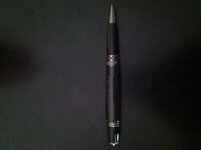remington590
Member
Hi, I'm new to the forum but have been turning pens for about 5-6 years now. I'm very frustrated and need some help, hopefully someone can tell me what I'm doing wrong. Last week I ordered a gun metal Mesa kit along with the carbon fiber artistiblank from woodturningz, I couldn't wait to turn it so as soon as the package arrived I set it up on the lathe and began turning. My problems began when I moved to the sanding steps and noticed what looked like an air void on the end, there was no way I could sand it out since it was under the resin. So frustrated, I called woodturningz and they agreed to send me another one (which is why I like woodturningz because of their great customer service). So yesterday I received the new blank and this morning I began turning on it only to find the same problem and then to make it worse I said oh well, pressed the clip and cap on and the void became bigger! Obviously I'm doing something wrong because I've seen many people/pictures with the carbon fiber and they're flawless! This is the first artistiblank pen I've attempted can someone please help me?? I have included a picture of the first attempt hopefully the picture quality is good enough to see.

